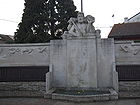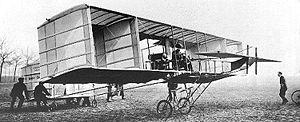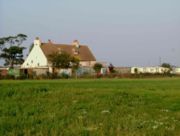
RAF Eastchurch
Encyclopedia

Royal Air Force
The Royal Air Force is the aerial warfare service branch of the British Armed Forces. Formed on 1 April 1918, it is the oldest independent air force in the world...
station near Eastchurch
Eastchurch
Eastchurch is a village on the Isle of Sheppey, in the English county of Kent, two miles east of Minster.The village website claims "... it has a history steeped in stories of piracy and smugglers".- Aviation history :...
village in the English
England
England is a country that is part of the United Kingdom. It shares land borders with Scotland to the north and Wales to the west; the Irish Sea is to the north west, the Celtic Sea to the south west, with the North Sea to the east and the English Channel to the south separating it from continental...
County of Kent
Kent
Kent is a county in southeast England, and is one of the home counties. It borders East Sussex, Surrey and Greater London and has a defined boundary with Essex in the middle of the Thames Estuary. The ceremonial county boundaries of Kent include the shire county of Kent and the unitary borough of...
. The history of aviation at Eastchurch stretches back to the first decade of the 20th century when it was used as an airfield by members of the Royal Aero Club
Royal Aero Club
The Royal Aero Club is the national co-ordinating body for Air Sport in the United Kingdom.The Aero Club was founded in 1901 by Frank Hedges Butler, his daughter Vera and the Hon Charles Rolls , partly inspired by the Aero Club of France...
. The area saw the first flight by a British pilot in Britain.
In 1910 it was offered to the Royal Navy
Royal Navy
The Royal Navy is the naval warfare service branch of the British Armed Forces. Founded in the 16th century, it is the oldest service branch and is known as the Senior Service...
as a training aerodrome and it was known as the Naval Flying School, Eastchurch. It was also in the 1910s the airfield was designated Royal Naval Air Station Eastchurch. With the amalgamation of the Royal Naval Air Service
Royal Naval Air Service
The Royal Naval Air Service or RNAS was the air arm of the Royal Navy until near the end of the First World War, when it merged with the British Army's Royal Flying Corps to form a new service , the Royal Air Force...
and the Royal Flying Corps
Royal Flying Corps
The Royal Flying Corps was the over-land air arm of the British military during most of the First World War. During the early part of the war, the RFC's responsibilities were centred on support of the British Army, via artillery co-operation and photographic reconnaissance...
on 1 April 1918, the station was transferred to the newly formed Royal Air Force and was re-designated Royal Air Force Station Eastchurch, or RAF Eastchurch for short.
Early civilian aviation

Leysdown-on-Sea
Leysdown-on-Sea is a coastal village on the east side of the Isle of Sheppey in the Borough of Swale in Kent, England.-History:It was noted in the Domesday book as being called Legesdun and the name is thought to be derived from the Saxon words "Leswe" and "Dun" .A very small hamlet up to late...
(known as Mussel Manor in 1909) the on the Isle of Sheppey
Isle of Sheppey
The Isle of Sheppey is an island off the northern coast of Kent, England in the Thames Estuary, some to the east of London. It has an area of . The island forms part of the local government district of Swale...
in 1909. One of the Club's members, Francis McClean, acquired Stonepits Farm, on the marshes across from Leysdown, converting the land into an airfield for members of the Aero Club. An club house was established at the nearby Muswell Manor.
It was at this ground that John Moore-Brabazon (later Lord Brabazon of Tara) made a flight of 500 yards in his Voisin. This is officially recognised as the first flight by a British pilot in Britain. Later in 1909, Moore-Brabazon piloted the first live cargo flight by fixed-wing aircraft. In order to prove the pigs can fly he attached a waste-paper basket to a wing strut of his aircraft and airlifted one small pig inside the basket. The Short Brothers
Short Brothers
Short Brothers plc is a British aerospace company, usually referred to simply as Shorts, that is now based in Belfast, Northern Ireland. Founded in 1908, Shorts was the first company in the world to make production aircraft and was a manufacturer of flying boats during the 1920s, 1930s, and 1940s...
, Horace, Eustace and Oswald, built aircraft at Battersea to be tested at the site. Later Moore-Brabazon, Professor Huntington, Charles Rolls
Charles Rolls
Charles Stewart Rolls was a motoring and aviation pioneer. Together with Frederick Henry Royce he co-founded the Rolls-Royce car manufacturing firm. He was the first Briton to be killed in a flying accident, when the tail of his Wright Flyer broke off during a flying display near Bournemouth,...
and Cecil Grace all visited and used the flying club's services. Wilbur Wright and his brother Orville came to the Isle of Sheppey to visit the new flying grounds of the Aero Club.
Also in early 1909, the Short Brothers
Short Brothers
Short Brothers plc is a British aerospace company, usually referred to simply as Shorts, that is now based in Belfast, Northern Ireland. Founded in 1908, Shorts was the first company in the world to make production aircraft and was a manufacturer of flying boats during the 1920s, 1930s, and 1940s...
established an aircraft factory at Shellbeach on Isle of Sheppey
Isle of Sheppey
The Isle of Sheppey is an island off the northern coast of Kent, England in the Thames Estuary, some to the east of London. It has an area of . The island forms part of the local government district of Swale...
. This was the first aircraft factory in the British Isles and the first factory in the world for the series production of aircraft. It built aircraft designed by the Wright brothers
Wright brothers
The Wright brothers, Orville and Wilbur , were two Americans credited with inventing and building the world's first successful airplane and making the first controlled, powered and sustained heavier-than-air human flight, on December 17, 1903...
. In May 1909 the Wright Brothers
Wright brothers
The Wright brothers, Orville and Wilbur , were two Americans credited with inventing and building the world's first successful airplane and making the first controlled, powered and sustained heavier-than-air human flight, on December 17, 1903...
, accompanied by Charles Rolls
Charles Rolls
Charles Stewart Rolls was a motoring and aviation pioneer. Together with Frederick Henry Royce he co-founded the Rolls-Royce car manufacturing firm. He was the first Briton to be killed in a flying accident, when the tail of his Wright Flyer broke off during a flying display near Bournemouth,...
and Professor Huntington, visited Sheppy, inspecting the airfield before moving on to the Short Brothers' factory. The group then took lunch at the Aero Club house at Muswell Manor and there was considerable discussion regarding the possibility of establishing a flying school in Sheppey.

Eastchurch
Eastchurch is a village on the Isle of Sheppey, in the English county of Kent, two miles east of Minster.The village website claims "... it has a history steeped in stories of piracy and smugglers".- Aviation history :...
, 2.5 miles (4 km) or so away, where the Short-Dunne 5, designed by John W. Dunne, was built and became the first tailless aircraft
Tailless aircraft
A tailless aircraft traditionally has all its horizontal control surfaces on its main wing surface. It has no horizontal stabilizer - either tailplane or canard foreplane . A 'tailless' type usually still has a vertical stabilising fin and control surface...
to fly. In 1911 they built the world's first successful twin-engine aircraft, the S.39 or Triple Twin. At this time seaplanes had to be taken by barge to Queenborough on the Isle of Sheppey
Isle of Sheppey
The Isle of Sheppey is an island off the northern coast of Kent, England in the Thames Estuary, some to the east of London. It has an area of . The island forms part of the local government district of Swale...
to be launched and tested.
Royal Navy use
In November 1910 the Royal Aero Club, at the instigation of Francis McClean, offered the Royal Navy the use of its airfield at Eastchurch along with two aircraft and its members as instructors in order that Naval officers might be trained as pilots. The AdmiraltyAdmiralty
The Admiralty was formerly the authority in the Kingdom of England, and later in the United Kingdom, responsible for the command of the Royal Navy...
accepted and on 6 December the Commander-in-Chief at the Nore
Nore
The Nore is a sandbank at the mouth of the Thames Estuary, England. It marks the point where the River Thames meets the North Sea, roughly halfway between Havengore Creek in Essex and Warden Point in Kent....
promulgated the scheme to the officers under his jurisdiction, stipulating that applicants be unmarried and able to pay the membership fees of the Royal Aero Club. The airfield became the Naval Flying School, Eastchurch. Two hundred applications were received, and four were accepted: Lieutenant C R Samson
Charles Rumney Samson
Air Commodore Charles Rumney Samson CMG, DSO & Bar, AFC was a British naval aviation pioneer. He also operated the first British armoured vehicles in combat...
, Lieutenant A M Longmore
Arthur Longmore
Air Chief Marshal Sir Arthur Murray Longmore GCB, DSO was an early naval aviator, before reaching high rank in the Royal Air Force.-Biography:...
, Lieutenant A Gregory and Captain E L Gerrard
Eugene Gerrard
Air Commodore Eugene Louis Gerrard CMG, DSO, RAF was an officer in the Royal Marines and Royal Air Force....
, RMLI. It was originally planned that Cecil Grace
Cecil Grace
-External links:*...
would be their instructor but, following his untimely death, George Bertram Cockburn
George Bertram Cockburn
George Bertram Cockburn OBE was a research chemist who became an aviation pioneer. He represented Great Britain in the first international air race at Rheims and co-founded the first aerodrome for the army at Larkhill. He also trained the first four pilots of what was to become the Fleet Air...
stepped into the breach and offered his services free of charge. Meanwhile, their technical instruction was provided by Horace Short
Short Brothers
Short Brothers plc is a British aerospace company, usually referred to simply as Shorts, that is now based in Belfast, Northern Ireland. Founded in 1908, Shorts was the first company in the world to make production aircraft and was a manufacturer of flying boats during the 1920s, 1930s, and 1940s...
.
Royal Air Force use
Towards the end of World War IWorld War I
World War I , which was predominantly called the World War or the Great War from its occurrence until 1939, and the First World War or World War I thereafter, was a major war centred in Europe that began on 28 July 1914 and lasted until 11 November 1918...
, on 1 April 1918, the Royal Naval Air Service
Royal Naval Air Service
The Royal Naval Air Service or RNAS was the air arm of the Royal Navy until near the end of the First World War, when it merged with the British Army's Royal Flying Corps to form a new service , the Royal Air Force...
and the Royal Flying Corps
Royal Flying Corps
The Royal Flying Corps was the over-land air arm of the British military during most of the First World War. During the early part of the war, the RFC's responsibilities were centred on support of the British Army, via artillery co-operation and photographic reconnaissance...
amalgamated. The station at Eastchurch was transferred to the newly formed Royal Air Force and was re-designated Royal Air Force Station Eastchurch, or RAF Eastchurch for short. During the last few months of the War, No. 204 Training Depot Station, the 64th (Naval) Wing and the 58th (Training) Wing were based at Eastchurch.
RAF Eastchurch remained active during the inter-war years and it was home to No. 266 Squadron
No. 266 Squadron RAF
-World War I:The squadron was formed from No's 437 and 438 Flights at Mudros, Greece on 27 September 1918 to carry out anti-submarine patrols in that area, flying Short 184s and 320s along with Felixtowe F.3s. In February 1919 it was transferred to the Caucasus on HMS Engadine. It operated from...
during the Battle of Britain
Battle of Britain
The Battle of Britain is the name given to the World War II air campaign waged by the German Air Force against the United Kingdom during the summer and autumn of 1940...
. During World War II, Eastchurch was part of Coastal Command
RAF Coastal Command
RAF Coastal Command was a formation within the Royal Air Force . Founded in 1936, it was the RAF's premier maritime arm, after the Royal Navy's secondment of the Fleet Air Arm in 1937. Naval aviation was neglected in the inter-war period, 1919–1939, and as a consequence the service did not receive...
. A siding was laid to connect RAF Eastchurch with Eastchurch railway station
Eastchurch railway station
Eastchurch is a disused railway station serving Eastchurch on the Isle of Sheppey. It opened in 1901 and closed in 1950.Former Services-External links:*...
on the Sheppey Light Railway
Sheppey Light Railway
The Sheppey Light Railway was a railway on the Isle of Sheppey, Kent, England which ran from Leysdown to Queenborough, where it connected with the South Eastern and Chatham Railway's Sheerness Line. It was engineered by Holman Fred Stephens and opened in 1901 and closed on December 4, 1950...
. RAF Eastchurch closed in 1946.
The site is currently used as HM Prison Standford Hill
Standford Hill (HM Prison)
HM Prison Standford Hill is a Category D men's prison, located close to the village of Eastchurch on the Isle of Sheppey, Kent. Standford Hill forms part of the Sheppey prisons cluster, which also includes HMP Elmley and HMP Swaleside...
. While there are a number of new buildings some of the original buildings survive including a number of pillboxes. The main roads in the prison reflect the aviation links; Rolls Avenue and Airfield View, Short's Prospect and Wright's Way. In the entrance to HMP Swaleside are two brass plaques; one records that the prison is built on what was the airstrip of RAF Eastchurch and the other lists the owners of the airstrip from 1901 to the end of the RAF use.

